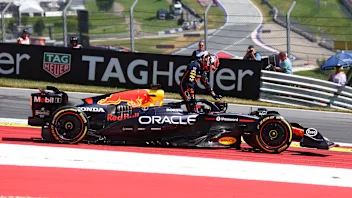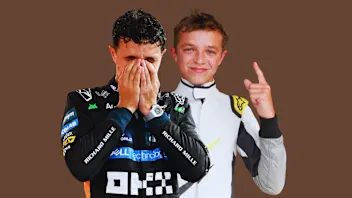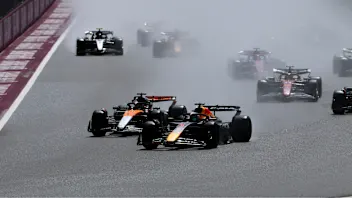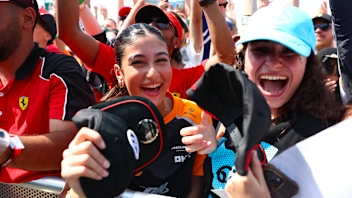In our series exploring the history of Grands Prix through a selection of iconic images, we turn our attention to the Hungaroring - home to the Hungarian Grand Prix since 1986.
This look back through history takes in defiant drives by Nigel Mansell and Thierry Boutsen, one of Michael Schumacher’s greatest ever victories, maiden wins for Fernando Alonso and Jenson Button, and more…
Piquet beats Senna in ‘battle of the Brazilians’, 1986
Formula One racing’s historic first race behind the ‘Iron Curtain’ was a humdinger with Nelson Piquet (centre) eventually taking the spoils ahead of disappointed countryman Ayrton Senna (left). The Brazilian duo fought over the lead for much of the Grand Prix until Piquet made the decisive move into Turn 1 on lap 57, dipping two wheels on the grass and snapping sideways before flamboyantly hurling his Williams around the outside of Senna’s Lotus. The elder Brazilian would eventually go on to win by over 17s, lapping team mate Nigel Mansell (right) in the process, as an estimated 200,000 spectators watched from the stands.
(© Sutton Images)
Mansell defies the odds, 1989
It was for races like the 1989 Hungarian Grand Prix that Nigel Mansell earned the nickname Il Leone (The Lion) from Ferrari’s devoted tifosi. A failure to get to grips with Pirelli’s qualifying tyres meant that Mansell started back in 12th place, but in the race the moustachioed Englishman tore through the field, oblivious to the notion that overtaking was supposed to be nigh on impossible at the Hungaroring. By lap 52 Mansell’s tenacity had hauled him up to second behind Ayrton Senna’s McLaren (leading Mansell in this picture), but the Ferrari man was not about to let the Brazilian waltz to his fifth victory of the season. Instead, Mansell kept the pressure on and when Senna hesitated whilst lapping Stefan Johansson’s Onyx on the 58th lap, the Englishman dived past. Mansell went on to finish over 25s ahead of Senna before declaring the race as “maybe the best of my life.”
(© Sutton Images)
Boutsen keeps Senna at bay, 1990
Like our first two ‘moments’, our third moment also recalls a race when Ayrton Senna - a winner in Hungary in 1988, 1991 and 1992 - had to settle for second best because of an inspired drive by a rival. This time the man to defeat the great Brazilian was Belgian racer Thierry Boutsen. The Williams driver - who started on pole - led every one of the race’s 77 laps on a single set of tyres, but to suggest his win was straightforward would be to do him a disservice, such was the amount of pressure he had to withstand from Senna, particularly in the closing stages. Boutsen is pictured here crossing the finishing line 0.288s ahead of Senna’s McLaren.
(© Sutton Images)
Hill performs heroics as Arrows narrowly miss the bull’s eye, Hungary 1997
No one expected Damon Hill to challenge for victory at the 1997 Hungarian Grand Prix; after all, he’d been having a torrid year for minnows Arrows. But, to the surprise of everyone, the combination of a tyre advantage and supreme driving skill took Hill and Arrows to within two miles of one of Formula One racing’s most unlikely triumphs. The reigning world champion had started third in his Bridgestone-shod, Yamaha-powered A18 but made use of a good start to jump up to second behind race leader Michael Schumacher’s Goodyear-shod Ferrari. Then, on lap 11, came the iconic moment captured in this photograph as Hill flung his car up the inside of Schumacher’s into the first corner. The Briton, suffering far less from tyre graining than many of his rivals, would go on to lead for 62 memorable laps before a hydraulics leak enabled Williams’ Jacques Villeneuve to catch and pass him on the final lap. Cruel luck.
(© Sutton Images)
Sublime Schumacher executes strategy to perfection, 1998
The 1998 Hungarian Grand Prix is rightly remembered for a driving masterclass by Ferrari’s Michael Schumacher, but the catalyst was surely Ross Brawn, the Scuderia’s technical director and strategy guru. With Schumacher trailing the McLaren’s in the opening stint of the race, Brawn took the bold decision to switch Schumacher from a two- to a three-stop strategy, but to make it work he told the German he was required to make up 20 seconds in 19 laps. In a display of incredible speed and consistency, Schumacher duly did just that and emerged from his final pit stop comfortably ahead of David Coulthard’s McLaren. This photo shows Schumacher (centre) celebrating on the podium in front of a jubilant crowd. To his right is second-place finisher David Coulthard and to his left is Jacques Villeneuve who finished third.
(© Sutton Images)
Alonso makes his mark with historic first win, 2003
Fernando Alonso was just 22 years and 26 days old when he took his (and Spain’s) maiden Grand Prix victory at the Hungaroring in 2003. The Spaniard, pictured here taking the chequered flag, surpassed Bruce McLaren as the youngest winner in F1 history, but there was nothing immature about his performance. Running a three-stop strategy, Alonso rocketed into the lead at the start and only relinquished it once, when he made his first pit stop on lap 13. For the rest of the race he was in complete control, the icing on the cake coming towards the end when he lapped both Michael Schumacher’s Ferrari and the Renault of team mate Jarno Trulli. A star had been born.
(© LAT Photographic)
Villeneuve flips Klien out of contention on a nightmare first lap for Red Bull, 2005
“It all happened so quickly,” said Red Bull’s Christian Klien after Sauber’s Jacques Villeneuve (who we’re riding onboard with in this picture) flipped him out of the race at the first corner in 2005. “I came to land on four wheels and luckily nothing happened, but that was not a good feeling…” But that wasn’t the end of Red Bull’s woes as moments later David Coulthard collected Fernando Alonso’s discarded front wing and ripped a wheel off his car. Rarely has a team had such an abysmal first lap.
(© Formula One World Championship Limited)
Button breaks his duck, 2006
Having burst onto the F1 scene with Williams in 2000, Jenson Button had to wait six and a half seasons - and 113 races - before finally tasting the winner’s champagne. His arrival on the top step of the podium in the 2006 race seemed improbable before the race given his P14 grid slot, but in wet-dry conditions the Briton brilliantly scythed his way through the field to second before inheriting the lead when Fernando Alonso’s Renault shed its right-rear tyre. Button’s triumph also gave Honda their first win as a fully-fledged F1 constructor since 1967.
(© Sutton Images)
Hamilton and McLaren claim first hybrid win, 2009
In November 2008 Lewis Hamilton sensationally claimed the world drivers’ title in Brazil, but by the Australian Grand Prix the following March his McLaren team were struggling. The Woking squad had missed the boat on the controversial but highly effective double diffuser and the MP4-29’s newly fitted Kinetic Energy Recovery system (KERS) had proved as much of a weight penalty as a performance benefit. But such was the pace of McLaren’s development that by July’s race in Hungary, Hamilton was right back in the thick of the action. He used KERS to his advantage at the start, jumping up to third behind Mark Webber’s Red Bull whom he dispatched three laps later with a fine around-the-outside pass at Turn 2. Then, when race leader Fernando Alonso made an early pit stop, the Briton went into a lead that he would never relinquish. Hamilton’s victory was not only the first of the season for McLaren; it was also the first in Formula One racing for a car equipped with hybrid technology.
(© LAT Photographic)
Schumacher crosses the line with former team mate Barrichello, 2010
As team mates at Ferrari Michael Schumacher and Rubens Barrichello enjoyed unprecedented success, but at the Hungaroring in 2010 - a track where they finished one-two in 2001, 2002 and 2004 - there appeared to be little love lost between the duo. The pair were fighting over tenth place (and the final world championship point) when Barrichello attempted to pass Schumacher’s Mercedes on the pit straight with four laps to go. Reluctant to cede the position, Schumacher (right) dangerously pushed the Williams (left) closer and closer to the pit wall until Barrichello finally forced his way by. The Brazilian was understandably nonplussed by his former team mate’s actions, as were the FIA stewards who penalised the seven-time world champion for ‘illegitimately impeding’ and handed him a ten-place grid drop for the next race in Belgium.
(© Sutton Images)
Next Up
Related Articles
 ‘I hated this car at times’ – Verstappen on his 2025 season
‘I hated this car at times’ – Verstappen on his 2025 season ExclusiveHow Norris made his school teachers ‘enormously proud’
ExclusiveHow Norris made his school teachers ‘enormously proud’ REVEALED: Your favourite race of the 2025 season
REVEALED: Your favourite race of the 2025 season Formula 1’s record-breaking 2025 season in numbers
Formula 1’s record-breaking 2025 season in numbers F1 AcademyHaas name Countryman as 2026 F1 ACADEMY driver
F1 AcademyHaas name Countryman as 2026 F1 ACADEMY driver Verstappen confirms new number for 2026 season
Verstappen confirms new number for 2026 season